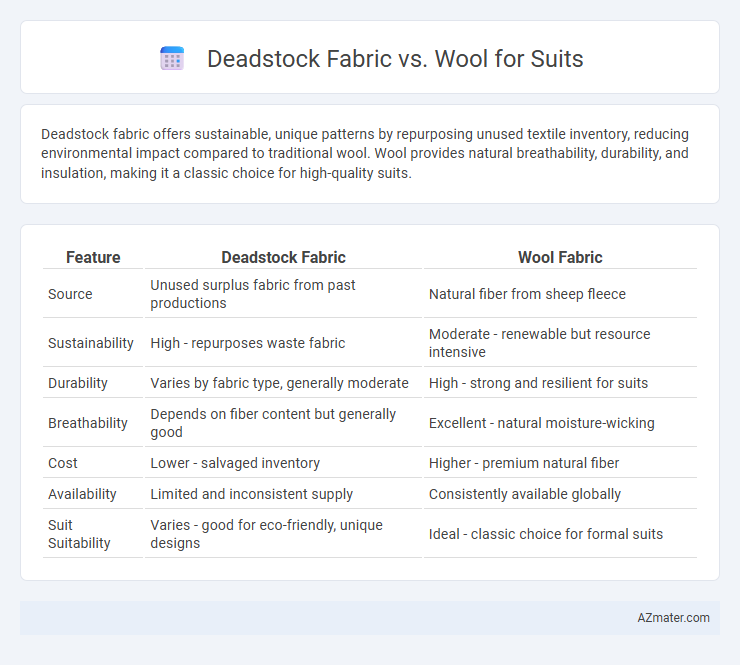Deadstock fabric offers sustainable, unique patterns by repurposing unused textile inventory, reducing environmental impact compared to traditional wool. Wool provides natural breathability, durability, and insulation, making it a classic choice for high-quality suits.
Table of Comparison
| Feature | Deadstock Fabric | Wool Fabric |
|---|---|---|
| Source | Unused surplus fabric from past productions | Natural fiber from sheep fleece |
| Sustainability | High - repurposes waste fabric | Moderate - renewable but resource intensive |
| Durability | Varies by fabric type, generally moderate | High - strong and resilient for suits |
| Breathability | Depends on fiber content but generally good | Excellent - natural moisture-wicking |
| Cost | Lower - salvaged inventory | Higher - premium natural fiber |
| Availability | Limited and inconsistent supply | Consistently available globally |
| Suit Suitability | Varies - good for eco-friendly, unique designs | Ideal - classic choice for formal suits |
Understanding Deadstock Fabric: Definition and Origins
Deadstock fabric refers to surplus or unused textile stock from past productions that remain unsold and are repurposed rather than discarded, often sourced from vintage or discontinued collections. This fabric embodies historical and environmental significance by reducing waste and preserving rare patterns or materials no longer in active manufacture. In contrast, wool used for suits typically involves freshly processed natural fibers from sheep, prioritized for their durability, breathability, and classic appeal in formal wear.
What is Wool? A Classic Suiting Material
Wool, a natural fiber sourced from sheep, is renowned for its breathability, durability, and insulating properties, making it a classic suiting material favored in men's fashion. Deadstock fabric refers to unused, surplus textile often from past collections, which can include wool, offering a sustainable alternative with unique patterns or textures. Choosing wool deadstock fabric for suits combines timeless elegance with eco-conscious production, ensuring high-quality garments with reduced environmental impact.
Sustainability: Deadstock Fabric vs Wool
Deadstock fabric promotes sustainability by repurposing excess textile inventory, reducing waste and minimizing the environmental impact of new fabric production. Wool, being a natural and biodegradable fiber, offers sustainability advantages through renewability and carbon sequestration during sheep grazing. Choosing deadstock fabric or wool depends on prioritizing waste reduction versus natural fiber benefits in sustainable suit production.
Cost Comparison: Which is More Budget-Friendly?
Deadstock fabric offers a cost-effective option for suits by utilizing surplus or leftover textile stock, significantly reducing material expenses compared to traditional wool. Wool suits, while renowned for durability and breathability, typically come at a higher price due to sourcing, processing, and quality grading. Choosing deadstock fabric can lower overall suit costs without compromising style, making it the more budget-friendly choice for cost-conscious consumers.
Performance and Durability in Suits
Deadstock fabric and wool differ significantly in performance and durability for suits. Deadstock fabric, often vintage or leftover textiles, can offer unique patterns and sustainable appeal but may vary in strength and wear resistance due to age and storage conditions. Wool suits excel in durability, breathability, wrinkle resistance, and natural stretch, making them superior for long-term performance and maintaining shape under daily wear.
Aesthetic Appeal: Texture, Color, and Patterns
Deadstock fabric offers a unique aesthetic appeal with its rare textures, vibrant colors, and vintage patterns that are often unavailable in contemporary wool suiting materials. Wool suits provide a classic, refined look with natural textures and a wide range of solid colors and subtle patterns, ensuring timeless elegance. Choosing deadstock fabric can result in a distinct, eye-catching suit with rich textures and nostalgic character, while wool ensures durability and a polished, sophisticated appearance.
Comfort and Breathability Factors
Deadstock fabric often provides unique, vintage textures but may lack the refined softness and breathability found in wool suits. Wool, especially merino or worsted varieties, offers superior moisture-wicking properties and temperature regulation, ensuring optimal comfort throughout daily wear. The natural elasticity and resilience of wool fibers enhance breathability and comfort, making it a preferred choice for tailored suits.
Suit Tailoring and Fit Considerations
Deadstock fabric offers a unique advantage in suit tailoring by providing vintage, high-quality materials that often have distinct textures and patterns not commonly found in modern wool. Wool remains a preferred choice for suits due to its natural elasticity, breathability, and wrinkle resistance, ensuring superior fit and comfort throughout the day. Tailors must consider the deadstock fabric's aging characteristics and potential fragility compared to wool's robust fibers, affecting drape and longevity in bespoke tailoring.
Availability and Sourcing Challenges
Deadstock fabric offers limited availability due to its nature as leftover or unsold textile from previous productions, making sourcing unpredictable and sporadic. Wool, especially high-quality variants like Merino or Super 120s, is more consistently sourced through established supply chains and reputable mills. Sourcing deadstock fabric requires extensive networking and quick procurement, whereas wool relies on seasonal shearing cycles and animal husbandry practices to maintain steady supply levels.
Choosing the Best Fabric for Your Suit
Deadstock fabric offers unique, limited-edition materials that are environmentally friendly and cost-effective, ideal for those seeking sustainable suit options. Wool provides superior breathability, insulation, and durability, making it a classic choice for year-round professionalism and comfort. When choosing the best fabric for your suit, consider the occasion, climate, and personal style to balance aesthetics with functionality.

Infographic: Deadstock Fabric vs Wool for Suit
 azmater.com
azmater.com